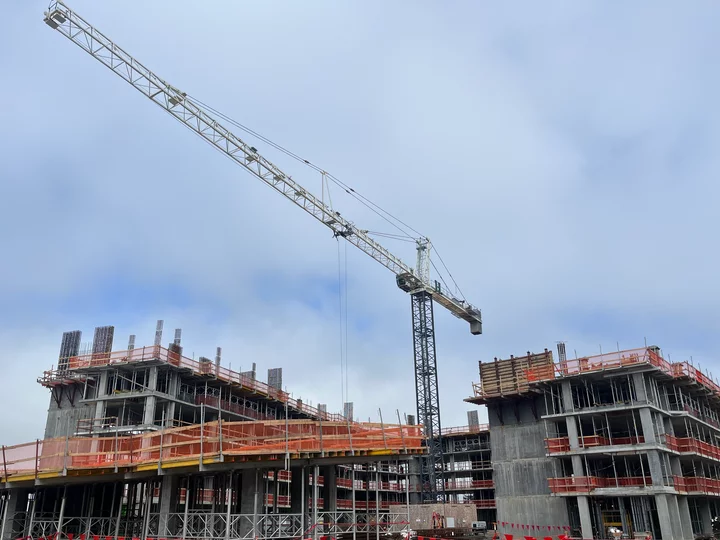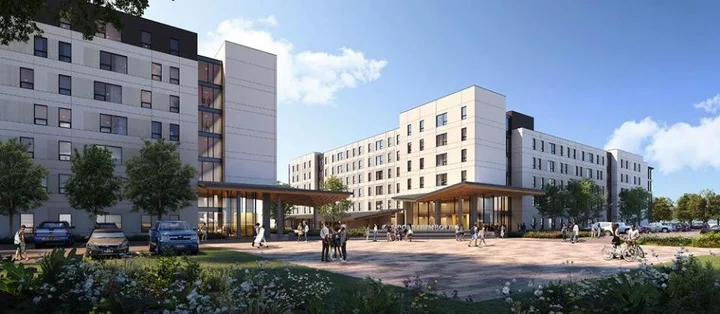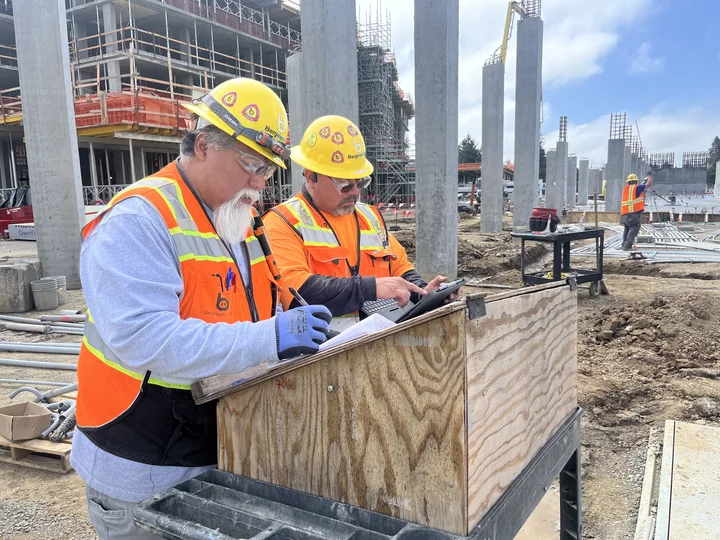One of the housing buildings under construction on the east side of the Craftman’s Mall site, and the familiar giant crane overhead. | Photos: Stephanie McGeary
###
It’s been nearly a year since Cal Poly Humboldt broke ground on the new student housing project at Arcata’s old Craftsman Mall sitee. Many of you have likely seen the giant tower crane or the top of the in-progress building poking above nearby trees.
The Outpost wanted to take a closer look, so last week we joined Mike Fisher, associate vice president of facilities management at CPH, and Fred Saldana, construction manager for FS3, for a tour to learn more about the largest development Arcata has seen in a long time. Once finished, the project will house up to 964 students at a time.
With construction still underway, it’s difficult to imagine the completed project, but Fisher and Saldana did their best to paint a picture as we toured the site.
The development includes two large buildings at staggered heights. The larger one, on the east side, will reach seven stories while the smaller will reach six. The taller building should be completed by the end of summer 2025, followed a few months later by the smaller one. Together they’ll hold 241 housing units, including two-, three- and four-bedroom apartments, each with its own kitchen and common room.
Fisher (left) and Saldana in front of the construction site.
In addition to housing, the project will include a gym, lounge areas, conference rooms and private study rooms. Between the two buildings will be an open walkway, which Saldana said will have the feel of a European “mews” – small, alley-like streets that aren’t open to vehicular traffic.
The site will have 320 parking spaces in multiple lots — not enough for every student to have their own space, but Fisher said alternative forms of transportation will be encouraged, and a shuttle service will run between the housing site and campus.
As part of the project, the university agreed to provide funding for the City of Arcata to complete a segment of the Annie and Mary Trail along the east side of the complex, and provide a shortcut for biking or walking to campus. Fisher said Arcata is trying to open the trail around the same time as the housing development.
The project will include covered bike storage in a one-story building just south of the main buildings. This building will also have a café, which will be open to the public, as will the project’s outdoor areas, though dorm rooms and certain other facilities will be accessible only to students.
Since many construction projects have been delayed due to the wet winter and supply chain issues compounded by COVID, we were pretty surprised when Saldana said the housing project is on schedule. He said the team planned for contingencies and while certain tasks, like pouring concrete, can’t be done in the rain, other work can be done in inclement weather, and planners obtained materials far in advance.
Still, the project had its unique challenges. Saldana and Shawn Marty, the project manager for Sundt Construction who joined the tour for a bit, explained that the long-unused property needed a lot of work before construction could begin. Temporary asphalt roads were added for trucks and machines access.
Above: what it looks like now. Below: what it is going to look like (rendering from CPH website)
“The key was getting the roads in so we wouldn’t be destroying the grounds,” Marty said. “And we got in the big stuff before the rains started.”
While laying down those roads, the team was surprised to unearth about 300 feet of buried railroad. Apparently, back when the site housed a sawmill, an industrial railroad spur was built to help load and unload materials from railcars.
The other big pre-construction step was getting the giant tower crane in place. Saldana said the crane was delivered in sections on 18 different trucks and assembled onsite.
With the development happening in quiet li’l Arcata, noise has been a public concern. However, the giant crane is not the culprit; it’s actually incredibly quiet when in use. But trucks’ backup beepers and other construction noise have led to complaints, Fisher said.
Project managers set a noise threshold with the City, Fisher said, and someone conducts “noise sampling” every two weeks to ensure the noise output is below that threshold. Of course, this doesn’t completely stop the complaints.
“It gives us a reference point, but people’s perception and experience is not just about numbers,” Fisher said. “If someone complains, we try to position [machines] in a different way or ask workers to limit use of their backup beepers or something like that. We try to be as flexible as we possibly can while still delivering the building on time.”
A pair of electricians map out their plans.
What about noise from partying students? Fisher said that, like the dorms on campus, each floor will have two to three resident advisors (RAs) in charge of monitoring and reporting issues to management, and the property will be patrolled by the University Police Department.
And for any neighbors worried about parties and general dorm-room debauchery, it might ease your concerns to know that the new buildings will be reserved for upperclassmen, while freshmen and sophomores will mostly be housed on campus.
With the project on schedule, Fisher said the housing should be ready for occupancy by fall 2025. The university will start marketing it this summer and assigning students to it next summer.
But with Cal Poly Humboldt’s enrollment numbers not nearly as high as expected after the transformation to a polytechnic, is this nearly 1,000-bed facility necessary?
Fisher believes it is, and he stressed that, although the growth has not been as rapid as the university anticipated, enrollment will continue to grow, even with total college enrollment decreasing over the past decade.
“Last year was about a 2.5 percent enrollment increase from the previous year,” Fisher said. “But we had lofty expectations, so the difference between those expectations versus what we’re experiencing is significant. But the story is we’re still growing amidst a higher education non-growth or even contraction.”
Fisher added that the new facility should help increase enrollment because once potential students see this impressive new development, they’ll really want to live there and will simply be unable to resist attending Cal Poly Humboldt.
“The better amenities we put out there, the more attractive we’ll be,” Fisher said. “And higher education is not just about the quality of the educational program; it’s also the quality of where you live.”
View of the construction from LK Wood Boulevard.
Another rendering of the plans, looking from the south.







CLICK TO MANAGE